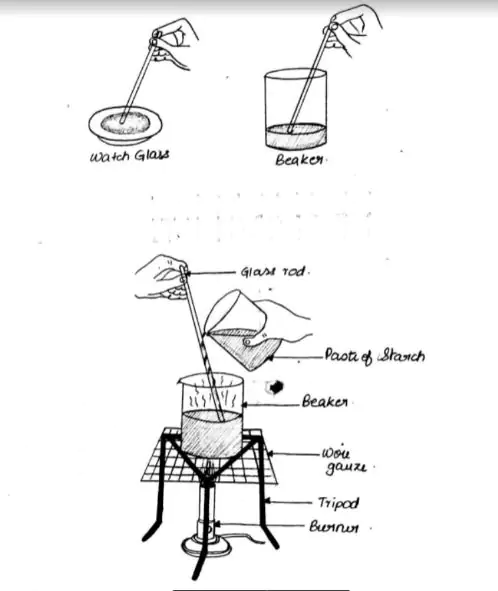‘UP Board Class 12 Chemistry Practical Book In English’ PDF Quick download link is given at the bottom of this article. You can see the PDF demo, size of the PDF, page numbers, and direct download Free PDF of ’12th Chemistry Practical Book Answers’ using the download button.
UP Board class 12 Prayogik Rasayan Vigyan (Chemistry Lab Manual) PDF Free Download

Class 12 Chemistry practical questions with answers Book For up Board
The replacement of hydrogen atom(s) in an aliphatic or aromatic hydrocarbon by halogen atom(s) results in the formation of alkyl halide (haloalkane) and aryl halide (haloarene), respectively.
Haloalkanes contain halogen atom(s) attached to the sp3 hybridized carbon atom of an alkyl group whereas haloarenes contain halogen atom(s) attached to sp2 hybridized carbon atom(s) of an aryl group.
Many halogen-containing organic compounds occur in nature and some of these are clinically useful. These classes of compounds find wide applications in industry as well as in day-to-day life.
They are used as solvents for relatively non-polar compounds and as starting materials for the synthesis of a wide range of organic compounds.
Chlorine-containing antibiotic, chloramphenicol, produced by microorganisms is very effective for the treatment of typhoid fever.
Our body produces the iodine-containing hormone, thyroxine, the deficiency of which causes a disease called goiter.
Synthetic halogen compounds, viz. chloroquine are used for the treatment of malaria; halothane is used as an anesthetic during surgery.
Certain fully fluorinated compounds are being considered as potential blood substitutes in surgery.
In this Unit, you will study the important methods of preparation, physical and chemical properties, and uses of organohalogen compounds.
These may be classified as mono, di, or polyhalogen (tri-, tetra-, etc.) compounds depending on whether they contain one, two, or more halogen atoms in their structures. For example, Monohalocompounds may further be classified according to the hybridization of the carbon atom to which the halogen is bonded, as discussed below.
This class includes (a) Alkyl halides or haloalkanes (R—X) In alkyl halides, the halogen atom is bonded to an alkyl group (R).
They form a homologous series represented by CnH2n+1X. They are further classified as primary, secondary, or tertiary according to the nature of carbon to which halogen is attached.
If halogen is attached to a primary carbon atom in an alkyl halide, the alkyl halide is called primary alkyl halide or 1° alkyl halide.
Similarly, if halogen is attached to the secondary or tertiary carbon atom, the alkyl halide is called secondary alkyl halide (2°) and tertiary (3°) alkyl halide, respectively.
(b) Allylic halides
These are the compounds in which the halogen atom is bonded to an sp3 -hybridized carbon atom adjacent to a carbon-carbon double bond (C=C) i.e. to an allylic carbon.
(c) Benzylic halides
These are the compounds in which the halogen atom is bonded to
The hydroxyl group of an alcohol is replaced by halogen on reaction with concentrated halogen acids, phosphorus halides, or thionyl chloride.
Thionyl chloride is preferred because in this reaction alkyl halide is formed along with gases SO2 and HCl. The two gaseous products are escapable, hence, the reaction gives pure alkyl halides.
The reactions of primary and secondary alcohols with HCl require the presence of a catalyst, ZnCl2.
With tertiary alcohols, the reaction is conducted by simply shaking the alcohol with concentrated HCl at room temperature.
Constant boiling with HBr (48%) is used for preparing alkyl bromide.
Good yields of R—I may be obtained by heating alcohols with sodium or potassium iodide in 95% orthophosphoric acid.
The order of reactivity of alcohols with a given haloacid is 3°>2°>1°. Phosphorus tribromide and triiodide are usually generated in situ (produced in the reaction mixture) by the reaction of red phosphorus with bromine and iodine respectively.
The preparation of alkyl chloride is carried out either by passing dry hydrogen chloride gas through a solution of alcohol or by heating a mixture of alcohol and concentrated aqueous halogen acid.
The above methods are not applicable for the preparation of aryl halides because the carbon-oxygen bond in phenols has a partial double bond character and is difficult to break being stronger than a single bond (Unit 11, Class XI).
From alkanes by free radical halogenation Free radical chlorination or bromination of alkanes gives a complex mixture of isomeric mono- and polyhaloalkanes.
| Author | – |
| Language | English |
| No. of Pages | 26 |
| PDF Size | 7.1 MB |
| Category | Chemistry |
| Source/Credits | Google.Drive.Com |
UP Board Class 12 Chemistry Practical Book PDF Free Download
